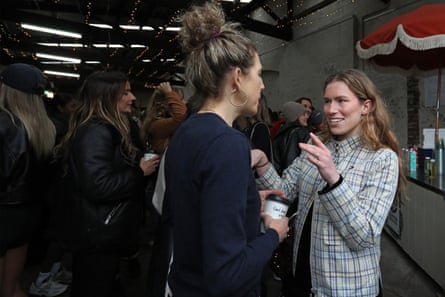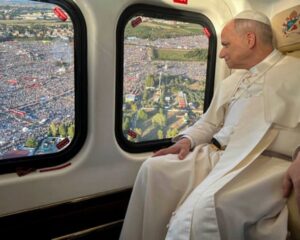The only ways I know to rave are festival-style or in the buzzed wee hours – the time between pubs shutting and trains starting. This means I’ve never walked into a cafe, fresh-faced and sober at 9am, with the intention of raving.
But this is 2025, not the late 1990s, and people are possibly more questioning of the cost of partying on their bodies than they once were. So, coffee raves have become a thing.
They’re all over the world and come in many shapes and sizes, tending towards the bijou. Inevitably, they’re big in Los Angeles and on social media, and are often the territory of young people, athleisurewear and brand collaborations.
They’re so popular, they’ve also become fair game. In a TikTok rant last week, musician Keli Holiday said what I might have been thinking: “Call me old, call me jaded, but enough is enough, no more coffee raves … If you want to get your rave on … go to a rave or go to a club.”
But on a rainy Saturday morning in central Sydney, I try one out – dubbed Maple Social Club – approaching with caution. I’m not a leisurewear wearer or an Instagrammer or indeed a coffee drinker.
My young adult life was, rightly or wrongly, given to maximum nights out and minimum responsibility – and my weekends now are generally about children and sleep. If there’s a cafe involved, it’s usually peaceful.
Organiser Taylor Gwyther, 25, tells me morning raves are an add-on to the night-time variety, not instead of. “But, there’s definitely a trend away from alcohol that I think encourages events like this to be popular,” she says as the first arrivals begin to enter the warehouse space behind Wilson cafe in Surry Hills.
Maple Social Club, which Gwyther founded with Connor Cameron, 23, is less than a year old and was inspired by run clubs and LA’s AM radio morning DJ sets. Their free events provide an alibi, Gwyther says, in the same way a run club is a little bit about running and a lot about meeting people.
“Covid shut down a lot of social life and created lonely adjacent habits, and people are looking to revitalise how they spend their time,” she says. “We spend so much time online for work and now play, I think people are looking for places and spaces to spend offline. We’re trying to make it easier to find those things.”
Morning raves also make sense on another, more local, level. Sydney residents are among the world’s earliest to bed and earliest risers. In a city whose nightlife sits well below its beaches, wealth and wellness reputations, mornings are sacrosanct.
Plus, it’s expensive to party the normal way in a city with a famously stratospheric cost of living. A beer is about $12 in the pubs nearby. Here, a coffee is about $5 – and there’s no need to buy a drink at all. Because, as Bronte, a 30-year-old nurse tells me later on the dancefloor, “Who’s got money these days, really?”
Michael Pung, 39, a property valuer from Sydney, saw the event advertised on Instagram.
“I thought I’d check it out. I’ve been single for a while and I thought I might as well just come out and meet people,” he says, queueing in the long and slow-moving coffee line – which, handily for him, doubles as another opportunity to meet people.
Like me, he’s not normally a coffee drinker but, given he was out late last night Latin dancing, he says “probably today’s the day”.
after newsletter promotion
I order a tea and a croissant, which feels plain weird, and join the throng as DJs Catch25 and Haze near the end of the opening set. It’s already busy and I feel too exposed, too daylit, too close to too many raised phones. But, everyone – and I really mean everyone – is smiling.
By 10am, the dancefloor is heaving with what feels like a roughly 50/50 mix of men and women. There are some older people, but generally the crowd is aged 20 to 35 – and as Gwyther predicted, “super diverse”. Some have made a morning of it and are wearing what I would consider proper going-out attire with high heels; others are grungy, and most are in baggy jeans.
Bronte, who lives locally, is here with friends. She says her evening and night shifts as a nurse mean she is often socially “removed from the night”. She’s sweaty and happy and hard to hear above the music. “I’ve done all my walking for the day,” she says, referring to another thing that didn’t used to be a thing: step count.
Like Pung, she also goes out at night-time, but having the option to dance her working week away come Saturday morning is, as she puts it, “very nice”.
The music’s not quite loud enough, or bassy enough, to lose myself – but, by about 10.30am, I think I might be dancing. People near me are drinking iced matcha lattes, which I’ll never condone, but as the DJ drops a relative banger, I admit to my colleague, who is photographing this road test, that I’m having quite an uplifting start to my weekend. The day is still young and there’s an afterparty at a pub nearby and yet another planned for the afternoon.
Before I leave (it’s approaching 11am after all) I turn to talk to a man who is watching on from close to the DJ area. Liam, 25, is almost-but-not-quite dancing, and it turns out he works for Red Bull events. He’s here professionally: might Maple’s coffee raves be worth bringing into the energy drink’s gargantuan sponsorship embrace?
“We see just as much relevance for Red Bull in an occasion like this [as] a music festival or the F1,” he says with no small amount of enthusiasm.
Stepping around some spilt milk, it strikes me there is no alcohol-edged aggro, argy bargy at the bar or intimidating bouncers. Just music and broad daylight – plus caffeine, in hot, cold and increasingly corporatised modes.











